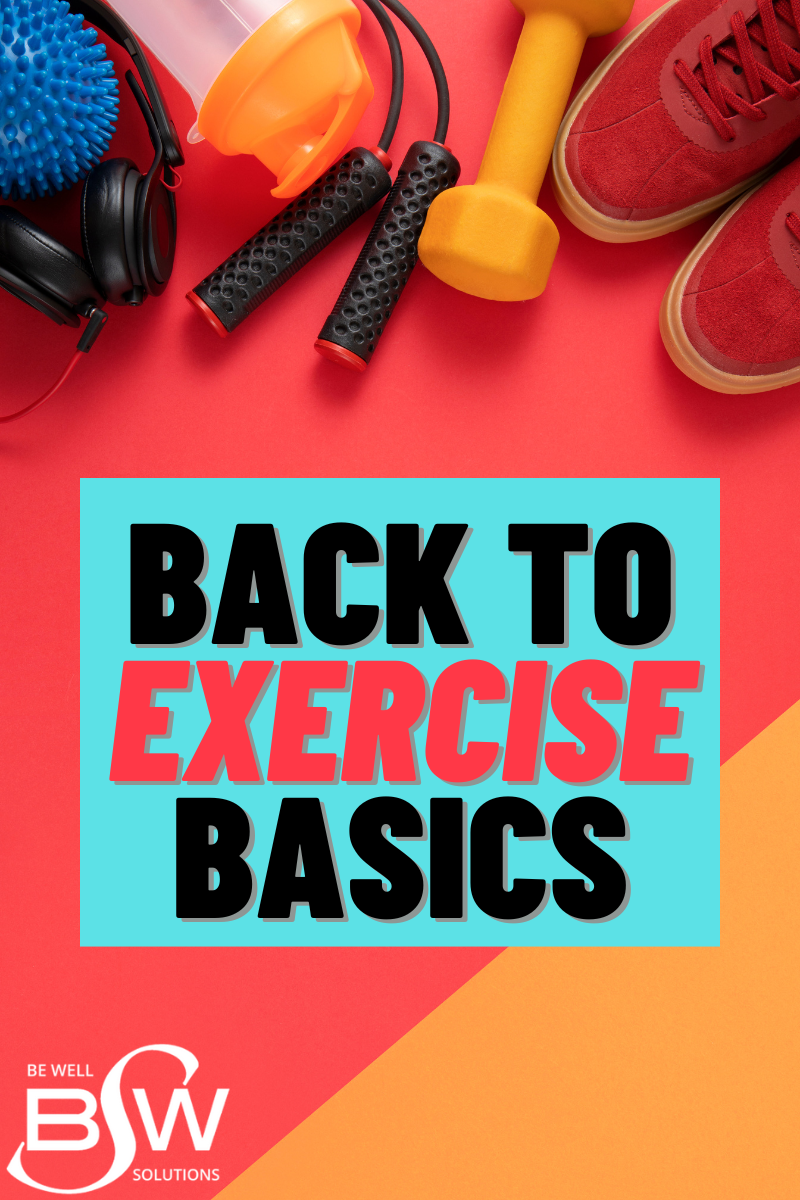
So, you want to create an exercise habit, but this is a new area for you. Or maybe it’s just been a while since you’ve had a good, consistent routine. Class is officially in session, and we’re going to take a closer look at the basics of exercise. When you start with the building blocks that form a solid foundation, it is easier to begin and stick to your exercise goals long-term.
What are the Recommendations?
First, let’s review the Physical Activity Guidelines set by the American College of Sports Medicine (ACSM) and the U.S. Department of Health. Adults are encouraged to participate in at least 150 – 300 minutes of moderate-intensity or 75 minutes of high-intensity aerobic activity each week. A combination of varying intensities is beneficial as well. Additionally, adults are encouraged to incorporate muscle-strengthening exercises that include all major muscle groups at least two days per week. For more exercise guidelines for children, older adults, and special considerations, check out the full Physical Activity Guidelines HERE. To maximize health benefits, an exercise routine should be well-balanced, consisting of aerobic, strength training, balance, flexibility, and rest. You should also aim to increase movement throughout the day and limit time spent sitting. Now that we’ve discussed the recommendations, we’ll explore each component closer.
Strength Training Basics
Strength training is important for building and maintaining muscular strength, endurance, and power. It can help support bones and connective tissue. It also helps regulate blood glucose levels and metabolism. You can use equipment like dumbbells, kettlebells, resistance bands, machines, and barbells. Or you can use your own body weight as the resistance for exercises like squats, push-ups, and lunges. At least one rest day should be placed between strength training for the same muscle group. This allows adequate time for your muscles to recover and get stronger. One of the most important things to remember with strength training is to always use proper form. You should prioritize form before speed, repetitions, or weight. This allows you to maximize benefits while limiting your risk of injury.
During a strength training session, you can aim to incorporate 6-10 multi-joint exercises that focus on a major muscle group or several muscle groups. Aim to perform two to three sets of eight to twelve repetitions. However, when you’re beginning, it’s more important to start slowly with only 1-2 sets and eight to ten repetitions. Focus on form first. As the exercise becomes easier, you can increase repetitions, sets, and/or weight.
Aerobic Exercise Basics
Aerobic exercise is often referred to as cardio exercise because it helps to improve and maintain cardiovascular health. It can assist in managing blood pressure, cholesterol, blood sugar, and weight. It also aids lung function and overall endurance. Aerobic exercise includes heart-pumping activities like walking, running, cycling, and swimming. It can be performed on consecutive days, but it is still important to choose a variety of activities to limit overuse injuries.
Intensity is different for everyone and can change as your body adapts to the activity. During aerobic exercise, it can be measured by watching your heart rate, ranking your intensity using an RPE (Rate of Perceived Exertion) scale, or using a talk test. A talk test can help you determine how hard you are working without extra equipment. During low-intense activity, you can still carry on a conversation, hum, or even sing. During moderate-intense activity, you might not be able to hum or sing anymore, but you can usually still speak a sentence or two at a time. High-intense activities make talking even harder. You’ll often find that you need to take a breath between each word in a high-intense workout. If you’re new to exercise, or if it has been a little while, you should always start easy with light to moderate intensity and gradually increase.
Other Considerations
Regardless of the type of workout you’re performing, you should always begin and end with a warm-up and a cool-down. A ten-minute warm-up of light to brisk movement with dynamic stretches will help prepare your body for exercise. It will gradually increase your heart rate and blood pressure, bringing oxygen-rich blood to the muscles you’re getting ready to use. It will also warm up the muscles you’re about to use, which maximizes range of motion and minimizes muscle strain. A cool-down is just as important. Once your exercise session is complete, you should perform a 5–10-minute cool-down of light activity along with stretching. This allows your body to gradually return to a resting state and helps relax the muscles that have just been contracted and working hard.
As you’re beginning, start with activities that you enjoy or at least find somewhat interesting. Try incorporating something else you like into your exercise session, like listening to a favorite podcast or calling up a friend during a walk. This can help remind you that exercise is something you GET to do, rather than a chore you MUST do.
If you’re unsure about an exercise, proper form, or personalized variations, consider talking with a certified personal trainer or exercise physiologist. It’s always important to exercise responsibly to promote health benefits rather than opening yourself up to complications or injury.
Always consult with your physician before starting a new exercise program.
Written by BWS Lead Health Coach- Kelly Schlather, BS, ASCM – CEP
Continue reading August 2022 Newsletter: Influenza Season is Upon Us
